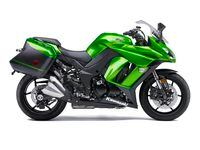We’ve often thought that Kawasaki’s entertainingly unruly Ninja 1000 was just a set of hard bags away from displacing a bunch of bigger bikes in our sport-touring affections. Hell, we found the Ninja to spin our cranks so hard we named it 2011’s Motorcycle of the Year. For 2014, the Ninja 1000 ABS gets sleek, tight-fitting hard cases as a dealer-installed option, but that’s just the start. Big K has unleashed a host of mechanical and electronic updates that should make the bike sweeter than ever. Cue the out-of-office auto reply. We need some time on the road to think.
Beneath the Ninja’s rakish skin are modifications meant to build a better all-around sporty bike. While the basic 1043cc inline-four powerplant—replete with engine-driven counterbalancer for smoothness—remains basically unchanged, it does receive new connecting passages between cylinders to reduce pumping losses, revised intake cams for improved low-end and midrange power, and an airbox fed through cool-air ducts upstream of new equal-length velocity stacks. A taller sixth gear should make for more relaxed highway cruising.
Kawasaki doesn’t say how much more power the Ninja makes—the previous version was good for “only” 120 horsepower but a prodigious 72 pound-feet of torque—yet whatever is coming will be backstopped by KTRC traction control, new to the Ninja this year. Three TC modes (plus off) join with two power modes (full and 70 percent) to tailor engine character. Kawasaki says the top two TC modes are designed to “maximize acceleration” while the third level is tuned for “low-traction” situations. As with the hard-core Ninjas, the TC control resides on an easily accessible rocker switch and not buried in some infernal instrument-panel menu system.
If you’re getting more power to the ground, it stands to reason you want better brakes. Kawasaki has obliged with new, one-piece “monobloc” front calipers to grip petal-style 300mm rotors and a radial master cylinder. Kawasaki points out, correctly, that this is leading-edge sportbike stuff we’re talking about.
So far, these updates seem as much about improving the Ninja’s sporting credentials, but there are several aimed at the long-distance rider. We’ll start with the new optional Kawasaki quick-release saddlebags (keyed to the ignition), holding 29 liters apiece and mounted to special brackets that leave very little visual evidence when the bags are removed. Company officials confirm that the bags hug the rear bodywork much better than the Givi-built option previously available for the big Ninja, definitely worth the effort of a new rear subframe. While Kawasaki’s engineers were back there, they enlarged the passenger handholds and fitted a remote hydraulic preload adjuster to the single, link-equipped shock.
Otherwise, the Ninja’s cast-aluminum frame, 41mm fully adjustable fork, 5-gallon fuel tank, manually adjustable (to three positions) windshield, and cushy two-piece saddle remain as before. The ‘14 Ninja 1000′s $11,999 is actually $100 lower than the previous machine’s. Prices for the dealer-installed saddlebags and mounting kit have not yet been released. And you might want to budget for a speeding ticket or two while you have the spreadsheet open. It’s likely the Ninja 1000 will be that kind of sport-touring machine.
















/cloudfront-us-east-1.images.arcpublishing.com/octane/VZZXJQ6U3FESFPZCBVXKFSUG4A.jpg)
/cloudfront-us-east-1.images.arcpublishing.com/octane/QCZEPHQAMRHZPLHTDJBIJVWL3M.jpg)
/cloudfront-us-east-1.images.arcpublishing.com/octane/HXOUJXQWA5HBHGRO3EMJIGFMVI.jpg)

/cloudfront-us-east-1.images.arcpublishing.com/octane/3TIWWRV4JBBOLDVGRYECVVTA7Y.jpg)
/cloudfront-us-east-1.images.arcpublishing.com/octane/KIX5O23D5NAIBGFXBN3327DKZU.jpg)
/cloudfront-us-east-1.images.arcpublishing.com/octane/7GJYDUIPXRGMTMQKN6ONYOLBOU.jpg)
/cloudfront-us-east-1.images.arcpublishing.com/octane/MUQLOVLL2ZDGFH25ILABNBXKTI.jpg)
/cloudfront-us-east-1.images.arcpublishing.com/octane/TNOU5DNE2BC57MFPMGN2EIDXAM.jpg)
/cloudfront-us-east-1.images.arcpublishing.com/octane/GTCXACQGJ5HAPDTGWUQKDEH44E.jpg)
/cloudfront-us-east-1.images.arcpublishing.com/octane/S35YGSEMEZB4BLTDJTSZPF4GLA.jpg)
/cloudfront-us-east-1.images.arcpublishing.com/octane/5UOT6HPX2JFMRJAX6EH45AR4MQ.jpg)
/cloudfront-us-east-1.images.arcpublishing.com/octane/OKWOJWAKP5EP3OACCRRWPCIX2Q.jpg)
/cloudfront-us-east-1.images.arcpublishing.com/octane/2WF3SCE3NFBQXLDNJM7KMXA45E.jpg)
/cloudfront-us-east-1.images.arcpublishing.com/octane/G4MG6OUCJNBSHIS2MVVOTPX65E.jpg)
/cloudfront-us-east-1.images.arcpublishing.com/octane/IIGGWFOTOJGB7DB6DGBXCCMTDY.jpg)
/cloudfront-us-east-1.images.arcpublishing.com/octane/QSTCM6AVEZA5JJBUXNIQ3DSOF4.jpg)
/cloudfront-us-east-1.images.arcpublishing.com/octane/U4I7G625B5DMLF2DVIJDFZVV6M.jpg)
/cloudfront-us-east-1.images.arcpublishing.com/octane/B6XD6LS6IVCQPIU6HXDJSM3FHY.jpg)
/cloudfront-us-east-1.images.arcpublishing.com/octane/ICL63FEDDRDTTMINYICCEYGMDA.jpg)
/cloudfront-us-east-1.images.arcpublishing.com/octane/FCGZHQXRBZFLBAPC5SDIQLVF4I.jpg)
/cloudfront-us-east-1.images.arcpublishing.com/octane/WNOB6LDOIFFHJKPSVIWDYUGOPM.jpg)

/cloudfront-us-east-1.images.arcpublishing.com/octane/X33NU3E525ECRHXLNUJN2FTRKI.jpg)